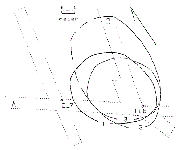| What did the first fractures look like? |
 |
| Excavation of fractures (Click to expand) |
|
| In 1987, three sand-filled fractures were created at the Center Hill Landfill in Cincinnati as part of the research projects funded by the US EPA. These fractures were created in glacial till that was mined eventually by the landfill operators for daily cover. However, prior to mining, trenches were dug to permit close observation of the fractures.
The exposure supports the plan of the three fractures as shown to the right. Fractures 1, 2 and 3 were nucleated 5 ft, 7 ft and 9 ft below surface from the same injection location, "EL6". We note that these fractures are elliptical in plan and extend several meters around the injection point from which they were created. Fractures tended to propagate northward - also the direction of downward surface slope. The decreasing overburden allowed fracture aperture to open more readily.
|
 |
| Plan of fracture extent. (Click to expand) |
|
|
 |
| Worm's eye view of fractures. (Click to expand) |
|
|
The photo to the left is looking along trench "B" from approximately the location of injection well "EL6". The regular white lines are horizontal strings while the white sand appears as the approximately parallel trace along the face of the trench. The white dot on the middle fracture is a coin. A hammer and shovel offer additional features of scale. These sub-horizontal fractures are nearly flat and parallel.
A closer perspective, shown to the right, reveals that the fracture maintains a relatively uniform aperture on the order of a centimeter along its length.
|
 |
| Close-up of exposed, sand-filled fracture (Click to expand) |
|
|
|